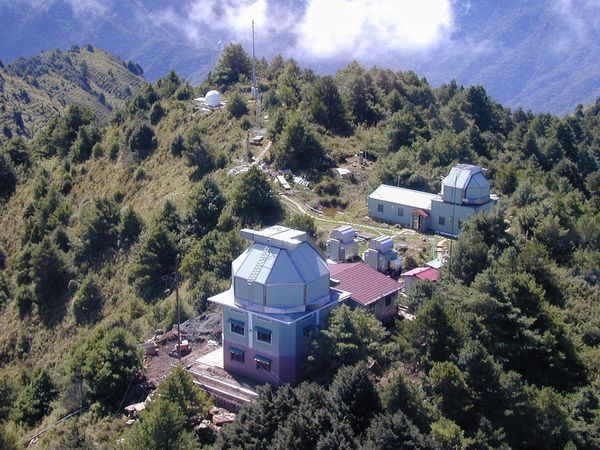LIMIT Overview
Last update:
Brief introduction of Lulin Observatory and Super Light Telescope
|
The NCU (National Central University) Lulin Observatory is located at Mt.
Front Lulin, 120 52' 25" E and 23 28' 07" N, a 2862-m peak in the Yushan
National Park. The construction of Lulin Observatory was finished on January 14,
1999. The initial study of Lulin site was started since late 1989. Later on, a
three-year project was founded by the National Science Council (NSC) to support
the development of a modern seeing monitor for this site survey study from 1990
through 1993. The average seeing of Lulin site is about 1.39 arc-second with
average 200 clear nights annually. The sky background of this site is 20.72
mag/arcsec^2 in V band and 21.22 mag/arcsec^2 in B band. (Reference:
Lulin
Observatory) Lulin Minor Bodies Tracking uses the 0.41-m (16-inch) f/8.8 Ritchey-Chrétien telescope (also
called Super Light Telescope) for observing, but sometimes it also uses the Lulin One-meter Telescope (LOT) for NEO or new comet follow-up purpose. The
Ritchey-Chrétien telescope manufactured by RC Optical Systems (RCOS). With the
instrument of Apogee Alas U42 back-illuminated CCD, and focal reducer installed, the field-of-view (FOV)
is about 38' x 38'.
Right: Bird view of Lulin Observatory, LOT dome on lower-left
and SLT dome on right.
|
 |
Normal operation flow
1. Preparation
1.1 Both side get in communication and check weather condition.
1.2 Quanzhi prepares the observing list for then night around 10-11hUT,
and transfer the list to then-observer.
1.3 Meanwhile, the then-observer at Lulin Observatory load the SLT system
in position.
2. Observing flow
2.1 Doing Searching Field 1 (SF1) and revisit the specific sky region in
10-20 minutes three or four times, depending the observing mode.
2.2 Finish doing SF1 and save the data to share disk.
2.3 Meanwhile, Quanzhi keep on the track until approaching his own
bed-time.
2.4 Continue doing the list until dawn.
2.5 After finishing observing tour, check all the observations and do reductions.
2.6 Observer goes to bed.
3. Processing flow
3.1 Quanzhi gets up and accesses the share disk, check and download the
observations.
3.2 Load the observations into automatic processing program and starts
processing routine.
3.3 Reviewing the candidates and preparing the MPC report.
3.4 Send the report to MPC, and prepare for next night's flow.
Software in use
The Sky 6
Use for telescope and CCD monitoring.
PinPoint 4
Use for reductions and observations processing.
Astrometrica
Use for manual measurements.
FindORB
Use for orbital computations.
LUSS Plan Master
Developed by Quanzhi, use for observing list customizing and SKYCOV list
producing.
Minor Planet Package
Use for statistics analyzing. Developed by Quanzhi.
Minor Planet Observer
Use for photometry purpose.
Minor Planet Cruiser
Under developing. It would be a powerful package that handle every angle
of the survey.
(c) Copyright 2006-2007 Lulin Minor Bodies
Tracking (LIMIT)

